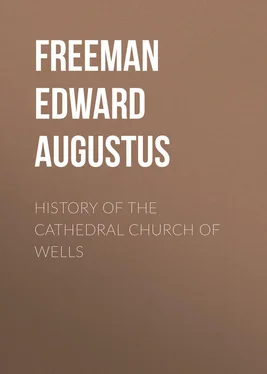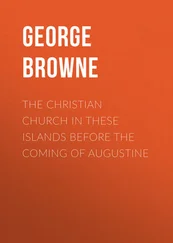Edward Freeman - History of the Cathedral Church of Wells
Здесь есть возможность читать онлайн «Edward Freeman - History of the Cathedral Church of Wells» — ознакомительный отрывок электронной книги совершенно бесплатно, а после прочтения отрывка купить полную версию. В некоторых случаях можно слушать аудио, скачать через торрент в формате fb2 и присутствует краткое содержание. Жанр: foreign_antique, foreign_prose, на английском языке. Описание произведения, (предисловие) а так же отзывы посетителей доступны на портале библиотеки ЛибКат.
- Название:History of the Cathedral Church of Wells
- Автор:
- Жанр:
- Год:неизвестен
- ISBN:нет данных
- Рейтинг книги:4 / 5. Голосов: 1
-
Избранное:Добавить в избранное
- Отзывы:
-
Ваша оценка:
- 80
- 1
- 2
- 3
- 4
- 5
History of the Cathedral Church of Wells: краткое содержание, описание и аннотация
Предлагаем к чтению аннотацию, описание, краткое содержание или предисловие (зависит от того, что написал сам автор книги «History of the Cathedral Church of Wells»). Если вы не нашли необходимую информацию о книге — напишите в комментариях, мы постараемся отыскать её.
History of the Cathedral Church of Wells — читать онлайн ознакомительный отрывок
Ниже представлен текст книги, разбитый по страницам. Система сохранения места последней прочитанной страницы, позволяет с удобством читать онлайн бесплатно книгу «History of the Cathedral Church of Wells», без необходимости каждый раз заново искать на чём Вы остановились. Поставьте закладку, и сможете в любой момент перейти на страницу, на которой закончили чтение.
Интервал:
Закладка:
Now this is a very remarkable story, as showing how tales grow, like snowballs rolled along the ground, and how dangerous it is to take things on trust from late and careless writers. You see at once how utterly different Gisa's own account of his own doings is from that in Collinson. The Canon of Wells and Bishop Godwin give the story in intermediate forms. I should strongly recommend those who are able to get at the books to compare all four accounts together. There cannot be a better example of the growth of a legend.
This Bishop Gisa, who succeeded Duduc in the year 1060, was a remarkable man in our local history. Like Duduc, he was a foreigner. Like several other Bishops at that time, he came from Lotharingia or Lorraine. But you must remember that the name Lorraine then meant, not only Upper Lorraine which is now part of France, but Lower Lorraine, a great part of which is now part of the Kingdom of Belgium. Gisa in short was what we should now call a Belgian, and he probably spoke the old tongue of those parts, which is one of the tongues of the Continent which is most like our own. He complains that, when he came to his diocese, he found his church mean and its revenues small; so much so that the four or five canons who were there had to beg their bread. 26 26 Historiola, p. 19, "publice vivere et inhoneste mendicare necessariorum inopia antea coegerat."
Of course I need not say that this is an exaggerated way of talking; but we may well believe that, like many a poor clergyman still, they were glad of any help that well-disposed people would give them. It is worth notice that another Bishop of the same time and of the same nation, Hermann, Bishop of the Wilsætas, complained that the revenues of his church at Ramsbury were so small that they could not maintain any monks or canons at all. Hermann mended matters in one way by getting the Bishoprick of Dorsetshire or Sherborne joined to that of Wiltshire and Berkshire, and in the end he moved his see to Salisbury, that is of course Old Sarum, whence it was afterwards again moved to the new city of that name. 27 27 For the story of Hermann, see Norman Conquest, ii. 401.
Gisa set to work to increase the revenues of his church by buying and begging in all directions. King Eadward gave him Wedmore; his wife, the Lady Eadgyth – remember that the proper title of the wife of a West-Saxon King was not Queen but Lady – gave him Mark and Mudgeley; William the Conqueror gave him the disputed lordships of Banwell and Winesham, and he bought Combe and lands at Litton and Wormestor or Worminster. 28 28 On these places see Historiola, pp. 18, 19. But it is as well to say that the well-known charter of Eadward to Gisa, printed in Cod. Dipl. iv. 162, is undoubtedly spurious, though it is useful as giving the names of places in the neighbourhood, in older, though not always their oldest, forms.
He was thus able to make a good provision for his canons; you will doubtless remember that many of the places which I have just spoken of give their names to prebends in the church of Wells to this day. He also greatly increased the number of canons, but he did something more. Among the things which he complains of is that the canons of Wells before his time had no cloister or refectory. This means that they did not live in common, but lived, after the manner of English secular priests, each man in his own house. They therefore had no need of a common refectory or dining-hall, nor had they any need of a cloister. In a monastery the cloister is one of the most important parts of the building; it is the centre of everything, all the other parts gathering round it; and it is always built in one particular place and of one particular shape, namely a square north or south of the nave of the church. In a monastery in short the cloister is a necessity; in a secular church it is a luxury, a thing which may be very well left alone. In our secular churches therefore we sometimes find a cloister and sometimes not, and, when there was one, it might be built of any shape and in any position that might be thought good. But in Gisa's country of Lorraine the secular canons were used to live in a much stricter way than they did in England. They were not monks, because they did not take vows; but they lived much more after the manner of monks, dwelling together with a common refectory and a common dormitory or sleeping-room, and being governed by very strict rules which had been drawn up by Chrodegang, Bishop of Metz in Upper Lorraine. 29 29 The rule of Chrodegang will be found at length in D'Achery's Spicilegium, i. 565; and see Norman Conquest, ii. 84.
You will see that the main object of all this was to hinder them from marrying, which the English secular priests, living each man in his own house, often did. Gisa's great object was to bring this discipline, the discipline, as he says, of his own country, into his church of Wells. This was what several Bishops about the same time were doing elsewhere. About a hundred years before Adalbero, Archbishop of Rheims, had done the same in his church, the metropolitan church of France. 30 30 This was about 969. Adalbero's changes are described at length by Richer, iii. 24, in Pertz's smaller collection.
But Rheims, you may remark, though in France and the head church of France, is quite near enough to the borders of Lorraine to come within the reach of Lotharingian influences. So in our own country, at this very time Leofric Bishop of Exeter was introducing the same discipline into his church. 31 31 See Norman Conquest, ii. 84.
But we find that Leofric, though by birth an Englishman, or perhaps rather a Welshman of Cornwall, had been brought up in Lorraine. It is always from Lorraine, in one shape or another, that this kind of change seems to come. And we have quite enough to show that Englishmen did not like it, as the changes which were brought in by Gisa and Leofric did not last very long either at Wells or at Exeter. Gisa, however, carried his point for the time. He built a cloister, a refectory, and whatever other buildings were needed for his purpose, and made the Canons live after the Lotharingian fashion. As their chief officer he appointed one Isaac, one of their own body, and whom they themselves chose. He was called the Provost, and his chief business was to look after the temporal concerns of the church.
Now in this account there are many things worthy of careful notice. First, mark the full authority of the Bishop in his own church; Gisa seems to do whatever he pleases. We need not suppose that he did what he did without obtaining the consent of his Chapter in some shape or other; but it is plain that the Bishop was still, to say the least, the chief mover in everything. One is also inclined to think that before Gisa's time the Canons had no property distinct from that of the Bishop. A large portion of his new acquisitions was bestowed to the benefit of the Canons; but it appears from Domesday that what they held at the time of the Survey was all held under the Bishop. 32 32 In Domesday Book, pp. 89-89 b , the land of the canons is put under that of the Bishop; "Canonici Sancti Andreæ tenent de Episcopo." This is much the same with the Canons of Exeter in p. 101 b . In the Exon Domesday, (71)"Isaac præpositus Canonicorum Sancti Andreæ" is mentioned by name.
Secondly, mark the very important change which Gisa made in the constitution of the church of Wells by bringing in the Lotharingian discipline. He did not, like some other Prelates, drive out his canons and put monks in their stead, nor yet did he, as was done at some other places, compel his canons to take monastic vows. The Canons of Wells, after his changes, still remained secular priests and not regulars. But the changes which he made were all in a monastic direction. They brought in something of the strictness of monastic discipline among a body of men who had hitherto lived in a very much freer way. I cannot help thinking that the rule of Chrodegang was but the small end of the wedge, and that before long it would, if not by Gisa, by some reforming Bishop or other, have been developed into the rule of Saint Benedict. But the next Bishop was not a reforming Bishop, and the fear of the Canons of Wells being displaced to make room for monks, or being themselves turned into monks, happily passed away. Gisa, there can be no doubt, was a good man and a diligent and conscientious Bishop, though some of his doings were such as we Englishmen are not likely to approve. At last, after being Bishop twenty-eight years, he died in 1088, and was buried under an arch in the wall on the north side of the high altar, as his predecessor Duduc was on the south side. 33 33 Historiola, 21: "Sepultus est in ecclesiâ quam rexerat, in hemicyclo [a semicircle or round arch] facto in pariete a parte aquilonali prope altare, sicut Duduco prædecessor ejus sepultus est a meridie juxta altare."
This notice is important; it shows that Gisa, among all his works of other kinds, did not rebuild the church itself; it also shows, by speaking of an arch in the wall, that the eastern part of the church had no aisles.
Интервал:
Закладка:
Похожие книги на «History of the Cathedral Church of Wells»
Представляем Вашему вниманию похожие книги на «History of the Cathedral Church of Wells» списком для выбора. Мы отобрали схожую по названию и смыслу литературу в надежде предоставить читателям больше вариантов отыскать новые, интересные, ещё непрочитанные произведения.
Обсуждение, отзывы о книге «History of the Cathedral Church of Wells» и просто собственные мнения читателей. Оставьте ваши комментарии, напишите, что Вы думаете о произведении, его смысле или главных героях. Укажите что конкретно понравилось, а что нет, и почему Вы так считаете.












